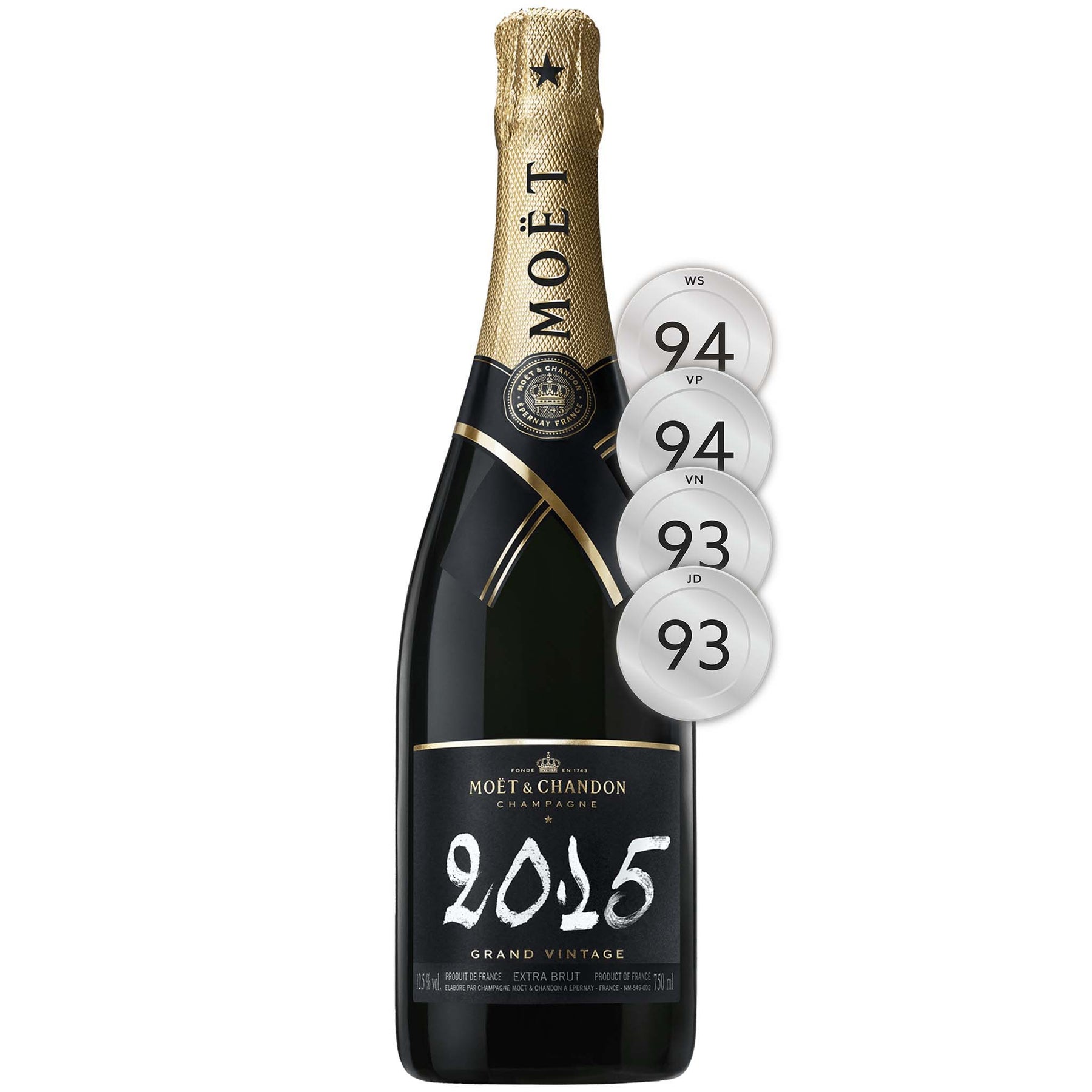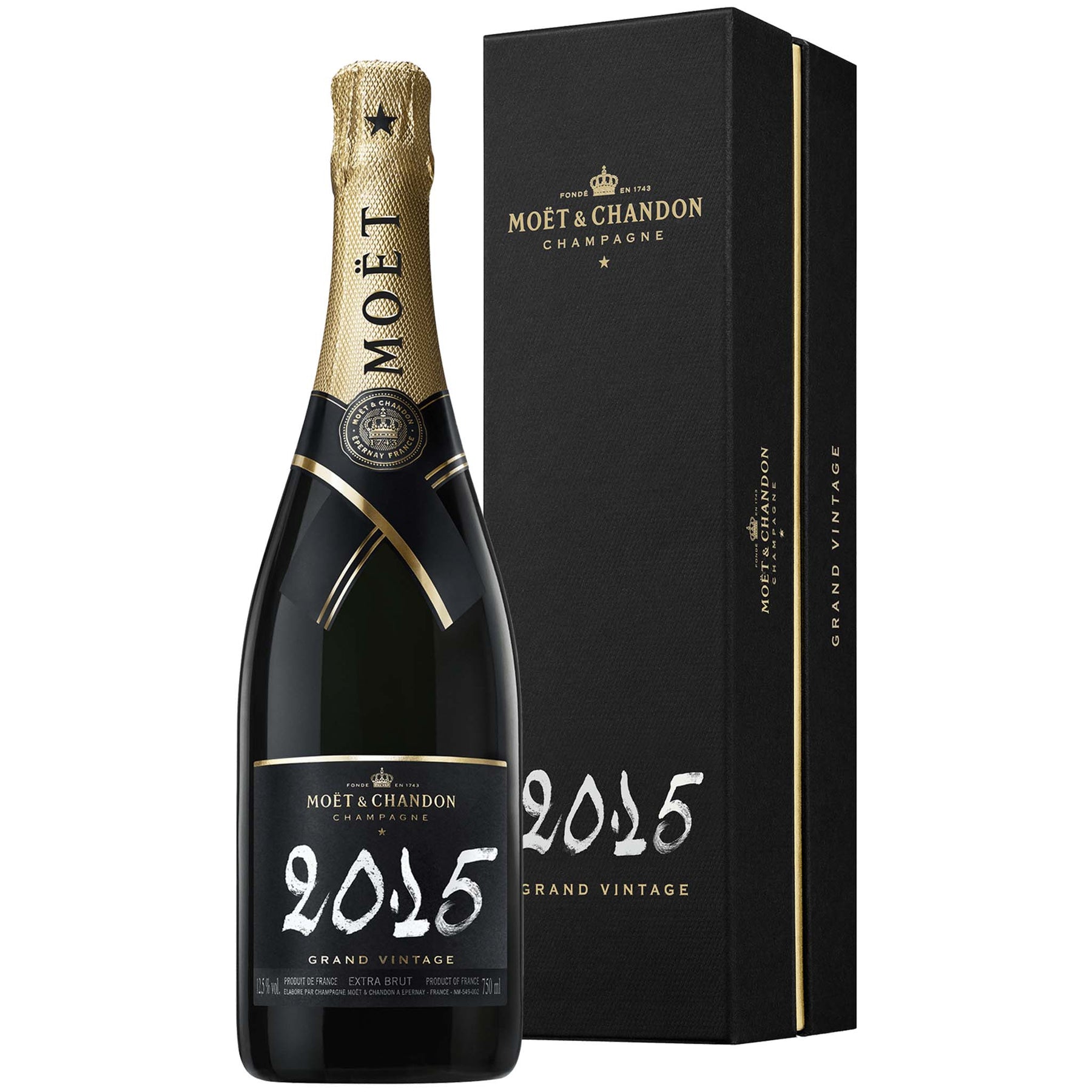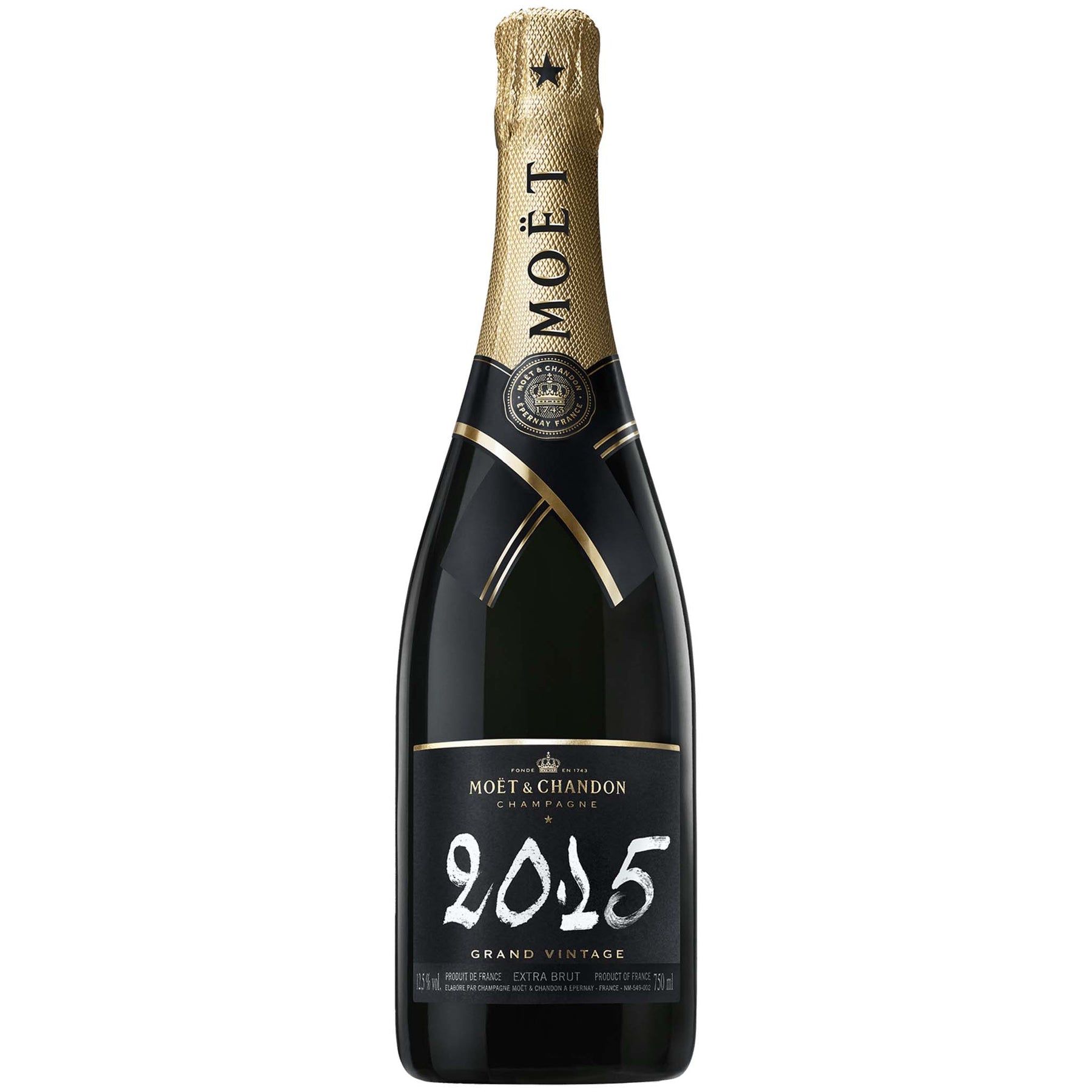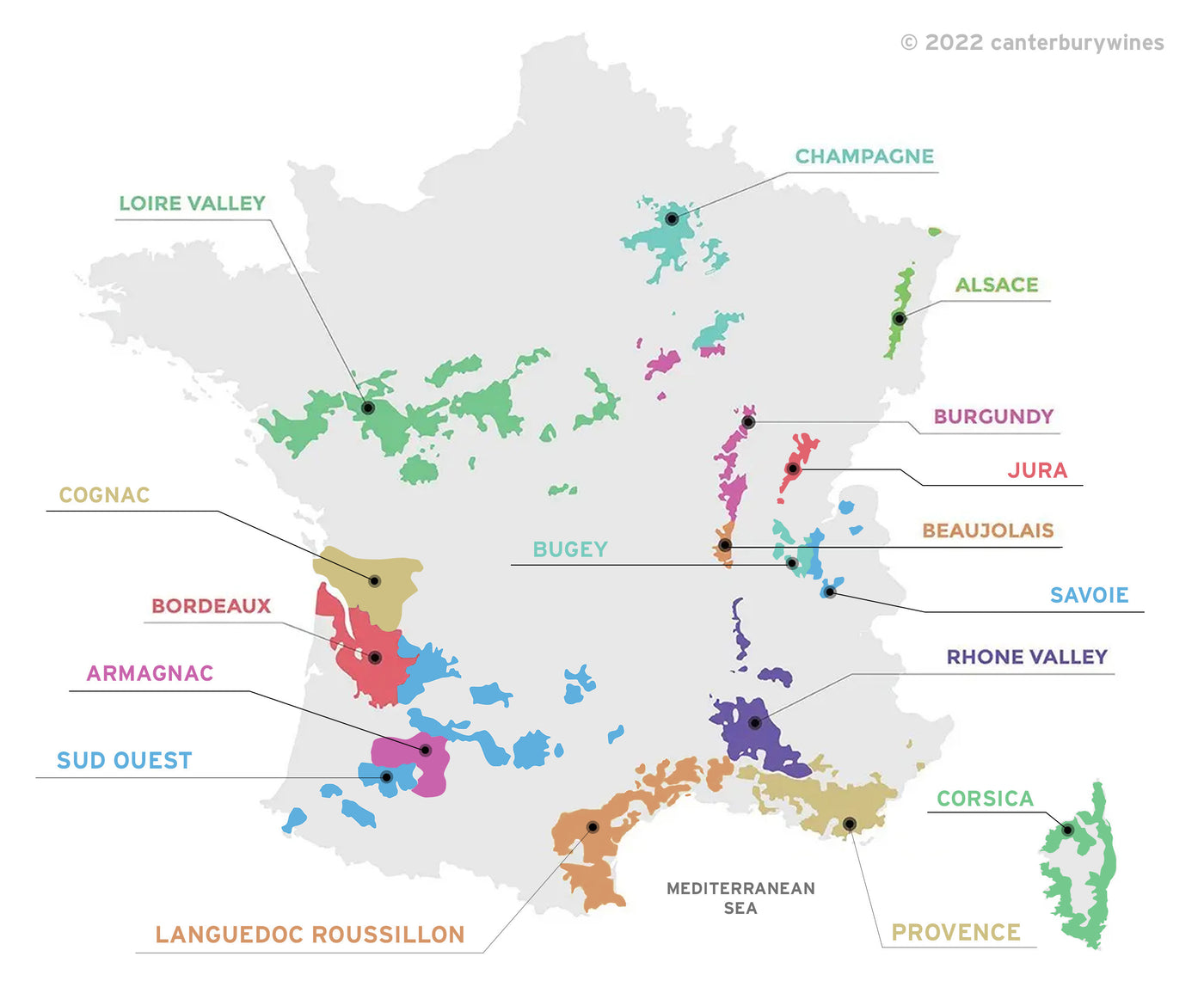


Moët & Chandon Grand Vintage 2015 (Gift Box)
Style: Champagne Extra Brut
Varieties: Pinot Noir (44%), Chardonnay (32%), Pinot Meunier (24%)
Closure: DIAM Cork
Moët & Chandon Grand Vintage 2015 (Gift Box)
Warehouse
34 Redland Drive
Vermont VIC 3133
Australia
Critic Score: 94
Alcohol: 12.5 Dosage: 5g/l
Size: 750 ml
Drink by: 2031
Moët & Chandon marketed its first vintage champagne in 1842. The current release Grand Vintage 2015 is the 76th vintage in the history of the House. Grand Vintage is a blend of the traditional varieties; Pinot Noir, Chardonnay and Pinot Meunier. The varietal blend varies year to year depending on vintage conditions as the base wines reflect the best qualities of the year’s harvest. The assemblage for the Grand Vintage 2015 was 44% Pinot Noir, 32% Chardonnay and 24% Pinot Meunier. The wine was aged on lees for 6 years in the cellars of Moët & Chandon. The dosage is 5g/l.
"A firm, focused Champagne, with a pleasing crunchiness to the fine mousse. Reveals a toasty edge, with notes of smoke, brioche and vanilla showing up front, before transitioning to underscore and enrich flavors of nectarine and plum fruit, salted almond, lemon curd and anise as they expand through the creamy finish." Wine Spectator
"A black and spicy bouquet. Initial aromas of sun-ripened dark berries – blackcurrant, blackberry and black cherry. Hints of fig and wild strawberry combine with spicy notes of pink berries and aromatic pepper, and allspice. Scents of flowery garrigue refresh the ensemble.
A powerful and faceted palate. The Pinot Noir dominates in a realm of power and extraction. The fruit is concentrated, dark and deep. The tannins create angles, revealing facets of a jewel in the rough. A salivating harshness of sloe and cranberry with notes of mint and aniseed completing the finish." Moët & Chandon
Expert reviews
"A firm, focused Champagne, with a pleasing crunchiness to the fine mousse. Reveals a toasty edge, with notes of smoke, brioche and vanilla showing up front, before transitioning to underscore and enrich flavors of nectarine and plum fruit, salted almond, lemon curd and anise as they expand through the creamy finish. Chardonnay, Pinot Noir and Pinot Meunier. Disgorged February 2022. Drink now through 2033." Alison Napjus, Wine Spectator - 94 points
"Since 1842, Moët & Chandon has released 76 vintage Champagnes, each expressing the cellar master's interpretation of a specific year. The 2015 vintage is composed of 44 percent Pinot Noir, 32 percent Chardonnay, and 24 percent Pinot Meunier. The result after six years of aging is a bright nose of apples and lemon zest with a mineral tinge. The palate is tart and assertive with smooth bubbles and well-balanced acidity. This is a great value vintage Champagne." Keith Beavers, VinePair - 94 points
"The 2015 Extra-Brut Grand Vintage is a terrific choice for drinking now, as it is so expressive. Baked apple tart, spice, lemon confit, marzipan and a hint of toastiness are front and center. Open-knit and engaging, the 2015 is a Champagne of pure and total pleasure. Drink 2022-2030." Antonio Galloni, Vinous – 93 points
"Produced from 44% Pinot Noir, 32% Chardonnay, and the rest Meunier, the 2015 Champagne Grand Vintage Extra Brut pours a medium golden-straw hue and is opulent on opening with toasty aromas of baked bread, spiced orange peel, marzipan, and dried peach. Full-bodied, with a pillowy mouthfeel, it has a very nice balance of ripe fruit while retaining freshness Silky textured, its notes of citrus oils and orchard fruits last through the finish. This elegant and warming wine would do fantastically well moving into these cooler fall and winter months. Although I personally enjoy where this is for drinking now, it should hold up over the coming 6-8 years. Disgorged February 2022. Drink 2023-2031." Audrey Frick, JebDunnuck.com – 93 points
Grand vintage

In 1842, 99 years after the foundation of the House, Moët & Chandon marketed its first vintage champagne. The current release Grand Vintage 2015 is the 76th vintage in the history of the House. Grand Vintage is a blend of the traditional varieties; Pinot Noir, Chardonnay and Pinot Meunier. The varietal blend varies year to year depending on vintage conditions as the base wines reflect the best qualities of the year’s harvest. For example, in 1999 Pinot Noir was the dominant varietal (38%), in 2002 Chardonnay (51%), while in in 2003 it was Pinot Meunier (43%).
Vintage wines are selected as the most interesting wines from the harvest, without thinking about house style. "The idea is freedom to create more variation from one harvest to another," says Chef de Cave, Benoît Gouez. Since 2000, there has been a decision to release the vintage at 7 years rather than 5 years. Dosage was reduced from 11g/l in 1998, to 9g/l in 2000, to 5 g/l in 2002. It has been kept at that level since then. Benoît has tried 2-3 g/l dosage, but the wines age too fast. "Sugar is a preservative," he says, "even a little bit of it. I don't think low dosage makes a Champagne better. It is a question of harmony."
The following text is taken from an article by Essi Avellan MW that appeared in Club Oenologique, March 2023.
It was not until 1842, 99 years after the foundation of the house, that Moët & Chandon produced its first vintage Champagne. In total, a mere 13 vintages saw the light of day in the 19th century, followed by much more frequent releases in the 1900s. The major turning point came in 1921, when the house bottled its first ever Dom Pérignon cuvée alongside its regular vintage release. Between 1921 and 1943, the wine inside both iterations was in fact one and the same, and even after production diverged, the wines coexisted in the Moët & Chandon portfolio for several decades. Dom Pérignon, however, was the cuvée de prestige and attracted most of the attention, as well as rapidly increasing in production volume. Its success meant that the standard Moët vintage was edged out of the limelight. On the plus side, though, for those in the know, the quality of the Vintage was always there – and indeed, the wine could be seen as very much undervalued compared to its more famous cousin.
When, some 15 years ago, Dom Pérignon was separated from Moët & Chandon and branded as a Champagne house in its own right, Moët’s vintage release was renamed Grand Vintage (the first official vintage under that name being 2000) in pursuit of wider, premium recognition. The wine was even given a chance to shine fully as a late-disgorged Grand Vintage Collection, showcasing much older vintages in an idea comparable to the Dom Pérignon P2 and P3 releases. Thus, in many ways, the link between the two cuvées remains tight.
Today, Grand Vintage represents a small fraction of Moët & Chandon’s output, similar in proportion to many other houses’ vintage Champagne. As a result, chef de cave Benoît Gouez can focus solely on quality, with full freedom of expression and little pressure to declare it. In fact, Gouez says there are very few rules in the making of Grand Vintage. He uses base wines that reflect the best qualities of the year’s harvest from Moët’s incomparably rich source, meaning the varietal blend can vary greatly from vintage to vintage. Some blends are dominated by Pinot Noir and others by Chardonnay, but surprisingly, Meunier can play a key role, too. (In 2003, Meunier registered a 43% share, proving that there really are no recipes when it comes to Grand Vintage.)
This autumn, Moët & Chandon released its 76th vintage, from the sunny and dry 2015 season. The declaration of 2015 was expected, even if the vintage has proven to be less exciting than the initial hype suggested. After all, the house has never been shy of making vintage Champagne in warm years, and it can boast a fine track record of outstanding examples throughout its long history. Adapting to climate change is a key part of this, and Gouez’s era as head of winemaking has seen dosage levels markedly reduced – as a response not only to the changing climate but also to evolving consumer taste.
‘I’m interested in showing a touch of noble bitterness in the wines, something beyond just acidity, for a more acquired taste,’ Gouez says in reference to the modest 5g/l sugar addition for hot, potentially phenolic vintages. Moving the style away from the more crowd-pleasing aspects of the house’s non-vintage bottlings is evident in the 2015 Grand Vintage, while the Grand Vintage Rosé goes a step further in boldly expressing its warm vintage Pinot Noir red wine component in both colour and character.
After a lengthy maturation in the cellar, Moët & Chandon vintages are ready to be enjoyed on release, but they are by no means at their grandest at that point. Thanks to the meticulous, reductive winemaking style and vast sourcing options, Grand Vintages are among Champagne’s most ageworthy cuvées. This, I got to witness first-hand last autumn, when we celebrated a century of Moët vintages at the maison. Gouez himself handpicked two great vintages from each decade, from 2008 all the way back to the house’s legendary 1921. Composed mostly of long-lees-aged magnums disgorged in front of us, the traditional way, without freezing the bottle neck and with no added sugar (making the wines brut nature), this once-in-a-lifetime tasting was a liquid testament to the quality of Moët & Chandon vintages.
Chef de cave

Benoît Gouez joined Moët & Chandon in 1998 as a winemaker and became the Chef de Cave in 2005 at only 35 years old. He's been in this role for 18 years, a mere blip in the House history dating back to 1743. Today he’s responsible for producing around 30 million bottles of champagne annually.
Benoît did not grow up in the Champagne region in northeast France. He was raised in Saint-Lô in neighbouring Normandy, "nowhere near a vineyard." He adds, "I don’t view this as a weakness, but rather as an opportunity, because I don’t have the weight of tradition on my shoulders.
His early interest was in science - he entered college in Montepellier in 1990, at the age of 20, to study agronomy. It was here he met his mentor, Denis Boubals, the professor of viticulture, and switched to viticulture and winemaking.
His professional life began not in France but in the New World world. An internship at a winery in California’s Anderson Valley was followed by stints at wineries in Margaret River in Australia and Cloudy Bay in New Zealand. These experiences made him, "realise that sometimes in France we can be fixated with regulations and the idea of 'vin de terroir', meaning the wine should express the place from where it originates. In the new world, the approach was different. It was more open to technical possibilities."
In 1998, at the age of 28, Benoît arrived in Champagne and was appointed as assistant winemaker at Moët & Chandon. He had been attracted by the combination of technical skill and sensitivity at the Mison, the values of pleasure and sharing wine, and the opportunities to travel. Seven years later he was appointed Chef de Cave.
"I’ve learnt a lot from Richard Geoffroy, the cellar master of Dom Pérignon. He taught me that, beyond technique, it’s the winemaker’s personal sensibility that gives a champagne its soul."
For Benoît, the most challenging aspect of the job is the production of the signature of the house, Moët & Chandon Impérial. "Each year, we face the awesome challenge of re-creating the Moët & Chandon Impérial with the same recognisable taste that is beloved around the world, despite having to use grapes that, at each harvest, are never the same in aroma or ripeness. To achieve both consistency and quality, we accompany the process of winemaking at every stage, from the blending of still wines made from three grape varieties within months of the harvest, through the careful elaboration and the bottling of the same Champagne style at Moët & Chandon year after year."
As for the biggest challenge facing the Champagne industry, he is in no doubt that it is adapting to climate change. "If things continue to evolve as fast as they have in the past 30 years, the discussion of the style of champagne will be pointless; the impact on our lives will be much more important. And second, if you think about what makes champagne unique, it is not in our varieties, or the way we prune, or the way we press, or ferment, or blend, or age. That can be done exactly the same way anywhere in the world. The only thing that makes champagne unique is what is here and nowhere else: the soil and the climate. When you understand that, you start asking what can I do to preserve the local environment? In the past 10 years we have cut by half the use of water. We work a lot on energy. In the vineyards we don’t use insecticides at all. We have a plan to not use herbicides at all within the next three years. Our identity is in our terroir, so we have to respect it, we have to preserve it, we have to even improve it."
About the winery

How to pronounce Moët
The Moët family makes it very clear that the 't' must be pronounced. It’s pronounced 'mo-wet' or 'moe-ette'. The Moët family is originally from the Netherlands and although they moved to France in the 1400s, they still tenaciously hold onto the Dutch pronunciation of their name. Quite brave in a country that would drop the consonant and pronounce the name 'Moe-ay'.
History
Moët & Chandon's history began in 1743 when Claude Moët, a wine merchant in Épernay, founded the Maison Moët. Moët developed over the next few generations as a brand and a business, but it was his grandson Jean-Rémy Moët, who helped create and globalize the Moët identity.
Jean-Rémy Moët was a visionary who built his namesake brand into one of the largest winemakers in the Champagne region. He built the framework for Moët & Chandon’s standing today, including the very chateau housing its headquarters in the heart of Épernay in the Champagne region, and the brand’s vast cellars, which run for some 28 kilometres underneath the city centre and out toward the miles of vineyards. The brand is Jean-Rémy’s legacy.
Jean-Rémy became a close personal friend of Napoleon Bonaparte and their friendship had a huge influence on the fortunes of Moët. The two met in 1782 when Napolean was at military school in Brienne-le-Château and the younger Moët visited the school soliciting orders for the family business. The word 'Champagne' was music to Napoleon’s ears and the two boys became fast friends. After Napolean became Emperor he made a point of visiting the Moët house to stock up on cases of Champagne before every military campaign. Napoleon famously said, "Champagne! In victory one deserves it, in defeat one needs it." After one terrible defeat, the Russian army plundered the cellars of Champagne and Jean-Rémy watched 600,000 bottles of Moët emptied by Russian soldiers camped on the premises. He didn't panic but instead recalled an old French proverb: 'Qui a bu, boira' or 'He who has drunk once will drink again.' Moët told all his friends, "All of those soldiers who are ruining me today will make my fortune tomorrow. I’m letting them drink all they want. They will be hooked for life and become my best salesmen when they go back to their own country." He was right; the Moët business soared in those following years and among the clients clamoring for a taste were some of Napoleon’s famous adversaries, including the First Duke of Wellington and Frederick William III of Prussia.
In 1832, nine years before Jean-Rémy died, his son Victor Moët took over the business and was joined by brother-in-law Pierre-Gabriel Chandon. In 1833, the company was renamed Moët et Chandon.
The concept of vintage champagne or millésimé was introduced in 1840. Two years later in 1842, 99 years after the foundation of the House, Moët marketed its first vintage. The current release Grand Vintage 2015 is the 76th vintage in the history of the House.
Brut Impérial, the House's signature wine, was first released in 1869 to celebrate the 100th anniversary of the birth of Napoleon Bonaparte. Today it is by far the biggest selling Champagne in the world - around 20 million bottles are produced each year, which is about 7% of Champagne’s total production.
In 1921, Moët & Chandon bottled its first ever cuvée de prestige alongside its regular vintage release. In 1937 they purchased the brand name 'Dom Pérignon' and released their 2021 prestige cuvée under that name. Some 15 years ago, Dom Pérignon was 'separated' from Moët & Chandon and branded as a Champagne house in its own right.
Moët & Chandon featured in the first recorded instance of anyone popping open a bottle of champagne and spraying it on others. Dan Turney was handed a jeroboam of the House's champagne in 1967 after he won the 24-hour Le Mans race and immediately proceeded to open the bottle and spray its contents on himself and the crowd, starting the now-timeless tradition.
Moet & Chandon merged with Hennessy Cognac in 1971 and then with luxury fashion brand Louis Vuitton in 1987, to become Louis-Vuitton-Moët-Hennessy (LVMH). LVMH is the world's largest and most successful purveyor of luxury goods, with an €80 billion revenue in 2022.

Vineyards
Moët & Chandon own 1,190 hectares of calcareous vineyards in the Champane region, 50% of which are classified as Grand Cru and 25% as Premier Cru. This makes them the largest vineyard owner in Champagne. However, the grapes from their estate vineyards only supply around 25% of their production needs, forcing them to purchase the balance from growers outside of these lands.
Moët & Chandon source their fruit from all the sub-regions of Champagne, namely Montagne de Reims, Côte des Blancs, Vallée de la Marne, Côte de Sézanne and Côte des Bar. In all, they have access to approximately 200 of the 323 crus in the region, including 100% of the 17 Grand Crus and 70% of the 44 Premiers Crus. This wide-range of vineyards allows the optimum selection of grapes, enabling them to maintain the constancy of Moët Impérial and the originality of Grand Vintage.
The Wines
Brut Impérial NV
Brut Impérial was first released in 1869 to celebrate the 100th anniversary of the birth of Napoleon Bonaparte, diminutive lover of bubbly and close personal friend of Jean-Rémy Moët, grandson of house founder Claude Moët. It is by far the biggest selling Champagne in the world - around 20 million bottles are produced each year, which is about 7% of Champagne’s total production.
Brut Impérial is a blend of over 200 crus, of which 20% to 30% are reserve wines. It is an assemblage of Pinot Noir (30 to 40%), Pinot Meunier (30 to 40%) and Chardonnay (20 to 30%). The dosage is 7g/l. Aged for a minimum of 2 years on lees.
Rosé Impérial NV
Rosé Impérial, first released in 1996, is now the market leader of Rosé in Champagne. It is an assemblage of around 45% Pinot Noir, 35% Pinot Meunier and 10% Chardonnay. Depending on the year, 20% to 30% of the blend are reserve wines specially selected to enhance its intensity, subtlety and constancy.
Grand Vintage
Moët & Chandon marketed its first vintage champagne in 1842. The current release Grand Vintage 2015 is the 76th vintage in the history of the House. Grand Vintage is a blend of the traditional varieties; Pinot Noir, Chardonnay and Pinot Meunier. Vintage wines are selected as the most interesting wines from the harvest, without thinking about house style.
The varietal blend varies year to year depending on vintage conditions as the base wines reflect the best qualities of the year’s harvest. For example, in 1999 Pinot Noir was the dominant varietal (38%), in 2002 Chardonnay (51%), while in in 2003 it was Pinot Meunier (43%).
Dom Pérignon
Dom Pérignon is named after a 17th century Benedictine monk who was Cellar Master at the Abbey of Hautvillers, near the town of Épernay. A vintage Champagne, it is a blend of approximately 50% Pinot Noir and 50% Chardonnay that showcases both the character of the year and the character of Dom Pérignon. It is the top Champagne (prestige cuvée or tête de cuvée) produced by Moët & Chandon and was first released in 1937 with the 1921 vintage. Although owned by Moët & Chandon, Dom Pérignon is now branded as a Champagne house in its own right.* It is aged in the cellars of Moët & Chandon for at least 8 years in bottle on lees before release.
* It is listed here under Dom Pérignon, not Moët & Chandon.

France
There are 16 major French wine regions, each known for their own unique grape varieties, terroir and wines. They are Alsace, Armagnac, Beaujolais, Bordeaux, Bugey, Burgundy, Champagne, Cognac, Corsica, Jura, Languedoc- Roussillon, Loire Valley, Provence, Savoie, South-West and the Rhône Valley.
The largest region is Languedoc- Roussillon, the oldest is Provence, the most influential and famous are Bordeaux, Burgundy, Champagne, Loire Valley and the Rhône Valley.
French wine is labelled by wine region or appellation rather than by grape variety (except in Alsace). In order to guarantee the quality and provenance of French wines, the French government established the Appellation d'origine contrôlée (AOC) system. Under this system the wine label indicates the geographical origin, quality and, generally, the style of a wine. Many regions are home to multiple appellations; for example, the prestigious Bordeaux region in the southwest of France has over 60 growing appellations.
